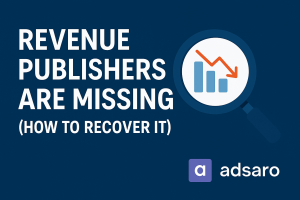The revshare pricing model is a revenue-sharing approach where advertisers and publishers split earnings based on a predefined percentage. Instead of paying per click or impression, advertisers compensate publishers based on actual revenue generated from conversions. This model is widely used in affiliate marketing, SaaS, and subscription-based services.
Unlike cost-per-click (CPC) or cost-per-mille (CPM) advertising, the revshare pricing model ensures that publishers earn a commission only when referred users make a purchase or generate revenue for the advertiser. This makes it an attractive pricing strategy for both parties, as it aligns incentives and minimizes financial risks.
How Does the Revshare Pricing Model Work?
The revshare pricing model operates on a simple principle: publishers earn a share of the revenue generated by referred users. Advertisers and publishers first agree on a revenue-sharing percentage, which may be a one-time commission or a recurring payout. Publishers then promote the advertiser’s product or service using content marketing, paid ads, or social media. Advertisers track conversions using advanced tracking tools and calculate earnings based on the agreed percentage. Finally, publishers receive payments according to the advertiser’s payout schedule.
For example, in an affiliate marketing program for a subscription-based software company, a publisher might earn a 30% commission on each new subscription sale. If a customer pays $100 monthly, the publisher would receive $30 per month for as long as the customer remains subscribed.
PROs
One of the biggest advantages of the revshare pricing model is that it ensures performance-based compensation. Unlike CPM or CPC models, where payments are made regardless of conversions, publishers are only rewarded when actual revenue is generated. This minimizes wasted ad spend for advertisers and ensures a fairer system for all parties involved.
Another key benefit is the long-term earnings potential. Many revshare agreements offer recurring commissions, allowing publishers to continue earning as long as their referred customers remain active. This is particularly beneficial in industries with high customer retention rates, such as SaaS and subscription-based services.
For advertisers, the revshare pricing model presents a lower financial risk. Instead of paying upfront for clicks or impressions that may not convert, they only compensate publishers when revenue is generated. This makes it a cost-effective alternative to traditional advertising models.
Additionally, the model incentivizes high-quality traffic. Since publisher earnings depend on actual user conversions, they are more likely to focus on bringing in high-intent audiences rather than merely driving traffic volume. As a result, advertisers benefit from better lead quality and higher customer lifetime value.
Finally, the revshare pricing model provides better ROI tracking. Advertisers can measure performance more accurately and adjust their marketing strategies based on real revenue data rather than engagement metrics.
CONs
Despite its advantages, the revshare pricing model comes with certain challenges. Revenue fluctuations are one of the main drawbacks. Publisher earnings are directly tied to user behavior, which can be unpredictable. Seasonal trends, economic conditions, and market demand can all impact revenue generation, making it difficult to maintain a stable income.
Another challenge is longer payment cycles. Since advertisers need time to track conversions and process payments, publishers may experience delays in receiving their commissions compared to other models like CPC or CPM.
Additionally, publisher success in this model relies heavily on advertiser transparency. Advertisers must provide accurate revenue reporting, and any discrepancies or lack of visibility can lead to disputes between parties. Establishing trust and using reliable tracking tools can help mitigate this issue.
The market for revshare partnerships is also highly competitive. With more businesses adopting the revshare pricing model, publishers must work harder to stand out. In some cases, increased competition leads to lower commission rates, making it essential for publishers to choose partnerships wisely.
Optimizing Campaigns with the Revshare Pricing Model
To maximize earnings with the revshare pricing model, publishers should carefully select their advertising partners. Not all revshare programs are equally profitable, and evaluating potential advertisers based on commission rates, conversion rates, product demand, and payout frequency can make a significant difference in profitability. Choosing advertisers with high customer retention rates can lead to more stable long-term earnings.
Leveraging data analytics is another crucial strategy. Tracking key performance indicators (KPIs) such as customer lifetime value (CLV) and average order value (AOV) helps publishers optimize their strategies for better profitability. Understanding audience behavior and engagement patterns allows for more effective campaign adjustments.
Targeting high-intent audiences is essential for success in the revshare pricing model. Using SEO, pay-per-click (PPC) campaigns, and retargeting ads ensures that traffic is more likely to convert into paying customers. Publishers should focus on niche markets where conversion rates are higher.
Diversifying revenue streams also plays a vital role in financial stability. Working with multiple advertisers reduces dependency on a single income source, allowing publishers to balance fluctuations in revenue from different partnerships.
Finally, a strong content strategy is key. High-quality content, such as, user generated contents, in-depth reviews, case studies, and product comparisons, improves credibility and drives higher conversion rates. Engaging and informative content increases audience trust, making them more likely to act on recommendations.
Industries That Benefit from the Revshare Pricing Model
Several industries effectively utilize the revshare pricing model to drive performance-based marketing. Affiliate marketing like CJ Affiliate is one of the most common applications, with e-commerce, SaaS, and tech companies leveraging revshare to boost sales. The online gambling and betting industry like Bet365 also widely adopts this model, with casinos and sportsbooks offering revenue-sharing commissions for referred players.
SaaS and subscription services use revshare to encourage affiliates to bring in long-term subscribers. Streaming and entertainment platforms, such as Netflix and Spotify, provide incentives for users who drive premium subscriptions. Financial services, including banks and fintech companies, also implement revshare models for referred credit card sign-ups and investment accounts.
Future Trends in the Revshare Pricing Model
As digital marketing continues to evolve, the revshare pricing model is expected to become more sophisticated. AI-powered attribution models are improving conversion tracking, allowing for more accurate revenue distribution. Blockchain technology is also being explored to enhance transparency in revshare agreements, ensuring fair compensation for publishers.
Hybrid pricing models, which combine revshare with fixed commissions, are gaining popularity to balance earnings stability. Additionally, more brands are incorporating revshare agreements into influencer marketing, enabling content creators to earn performance-based commissions.
Conclusion
The revshare pricing model is a highly effective approach that aligns advertiser and publisher incentives, offering long-term earning potential while minimizing risks. Though it comes with challenges like revenue fluctuations and delayed payments, optimizing campaigns through strategic partnerships, data-driven decision-making, and high-quality content can significantly enhance profitability. Whether you are an advertiser or a publisher, leveraging revshare effectively can lead to sustained revenue growth in the ever-evolving digital marketplace.








Leave a Reply